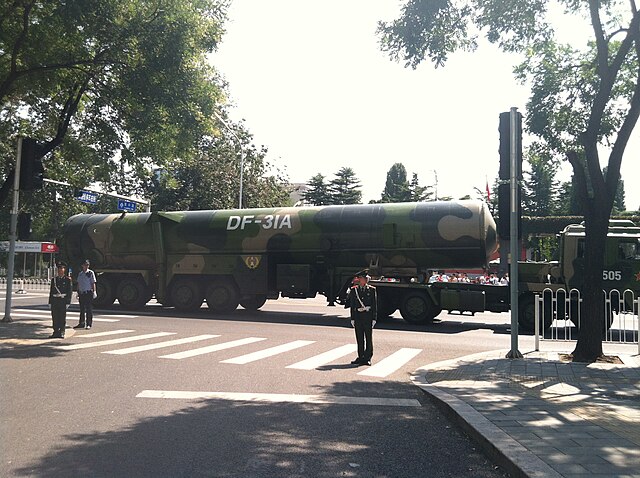The Dong Feng 31 (simplified Chinese: 东风-31; traditional Chinese: 東風-31; lit. 'East Wind-31'; NATO reporting name CSS-10)[5] is a third-generation long-range, road-mobile, three stage, solid-fuel rocket intercontinental ballistic missile (ICBM) in the Dongfeng missile series developed by the People's Republic of China. It is designed to carry a single 1-megaton thermonuclear weapon. It is a land-based variant of the submarine-launched JL-2. It is operated by the People's Liberation Army Rocket Force (PLARF). In 2009, the Chinese inventory was estimated as under 15 DF-31 missiles and under 15 DF-31A missiles.[6] US Air Force National Air and Space Intelligence Center estimates that as of June 2017, five to ten Mod 1 and over fifteen Mod 2 launchers were operationally deployed.[7]
| DF-31 (CSS-10) | |
|---|---|
 DF-31 in Military Museum of the Chinese People's Revolution | |
| Type | Intercontinental ballistic missile |
| Place of origin | People's Republic of China |
| Service history | |
| In service | 2006 (DF-31), 2007 (DF-31A), 2017 (DF-31B) |
| Used by | People's Liberation Army Rocket Force |
| Production history | |
| Manufacturer | Academy of Rocket Motors Technology (ARMT) |
| Specifications | |
| Mass | 54 t (54,000 kg; 60 short tons) |
| Length | 21.6 m (70 ft 10 in) |
| Diameter | 2.37 m (7 ft 9 in) |
| Warhead | 1 x 1 Mt or 5 x 90kt[1] |
| Engine | Solid-fuel rocket |
Operational range | 7,200–8,000 km (4,500–5,000 mi) (DF-31)[2][3] 13,200 km (8,200 mi) (DF-31A)[3] |
| Flight altitude | up to 1200 km |
| Maximum speed | Up to 8.16 km/s |
Guidance system | Astro-inertial guidance with BeiDou Navigation Satellite System |
| Accuracy | 100 m CEP for silo launched and 150 m for TEL-launched.[4] |
Launch platform | Silo, 8 axle TEL |


History
The PRC began developing the DF-31 ICBM in January 1985.[8] ARMT (then called the 4th Aerospace Academy) was appointed as the main contractor while the research arm of the Second Artillery Corps (SAC) which, provided contributing support. The land-based variant of the JL-2 was originally called the DF-23 but was changed later on to the DF-31 because of a change in operational requirements. In 1999, the missile was first displayed publicly at the National Day Parade.[9] On August 2, 1999, the Chinese state news media reported the successful test of the DF-31.[8] The third test flight of the missile occurred on November 4, 2000; the second test flight had taken place earlier that year.[10] Operational deployment of the missiles reportedly began in 2006.[11] In 2009, US Air Force Intelligence reported that under 15 DF-31 missiles had been deployed.[6]
Description
The DF-31 is a three stage solid-fuel rocket equipped with an inertial navigation system. The missile is mounted on a transporter erector launcher. It is capable of reaching targets throughout Europe, Asia, and parts of Canada and the northwestern United States.
DF-31A
The PRC has developed an improved variant of the DF-31 called the DF-31A. This upgraded missile has a reported range of 13,200 km,[3] will allow targeting of most of the continental United States[7] and was designed with MIRV capability to hold 3 to 5 warheads, each capable of a 90 kt yield, but is thought to be armed with only one warhead with penetration and decoy aids to complicate missile defense efforts.[1][6] The missile was shown to the public during the parade in Beijing celebrating 70 years since the end of World War II on September 3, 2015.[12] It can carry maneuverable reentry vehicles.[13]
DF-31AG/DF-31B
The PRC has developed an improved variant of the DF-31A called the DF-31AG (G stands for 改 (Gaï), "modified)[14] or DF-31B with an off-road 8 axle TEL and MIRVs.[15][16] China has successfully tested it from a mobile launcher.[17] The missile's TEL features an extra pair of elevators near the aft of the missile unlike the TELs of the DF-31 or DF-31A, suggesting a heavier missile second and third stage than earlier variants.[18] On the military parade marking the 90th Anniversary of the founding of the People’s Liberation Army in 2017, DF-31AG ICBM was officially demonstrated.[19]
References
Further reading
External links
Wikiwand in your browser!
Seamless Wikipedia browsing. On steroids.
Every time you click a link to Wikipedia, Wiktionary or Wikiquote in your browser's search results, it will show the modern Wikiwand interface.
Wikiwand extension is a five stars, simple, with minimum permission required to keep your browsing private, safe and transparent.
